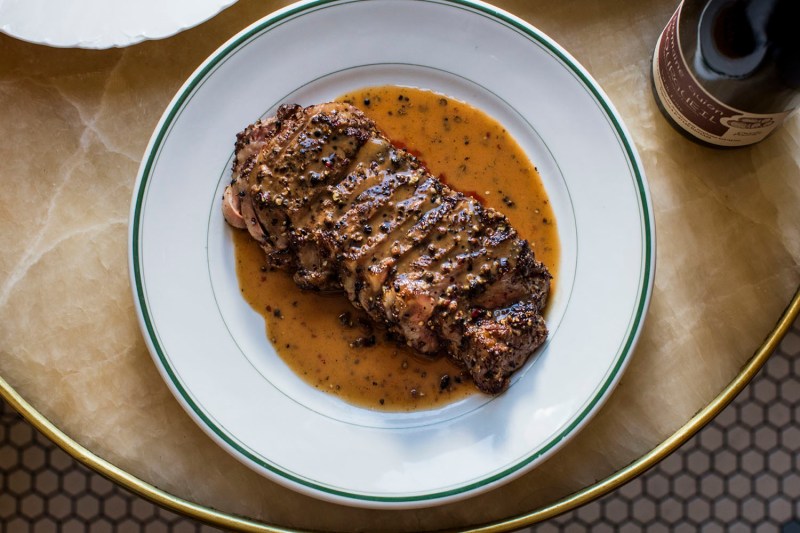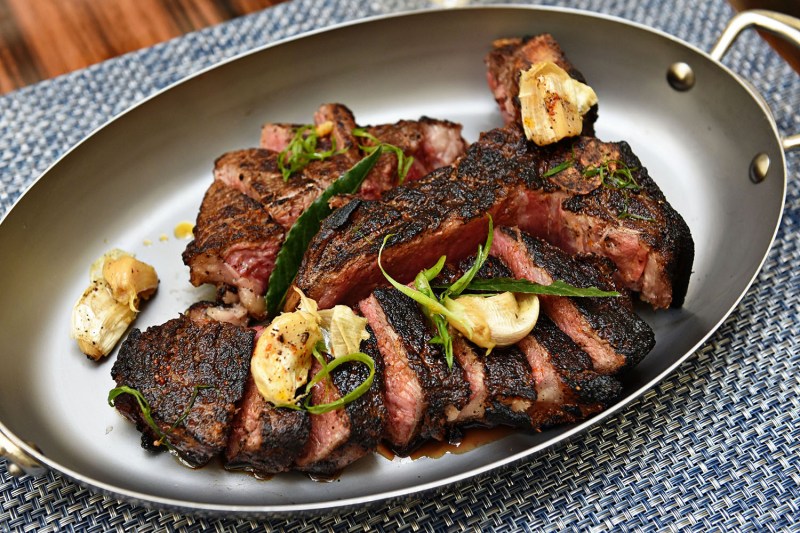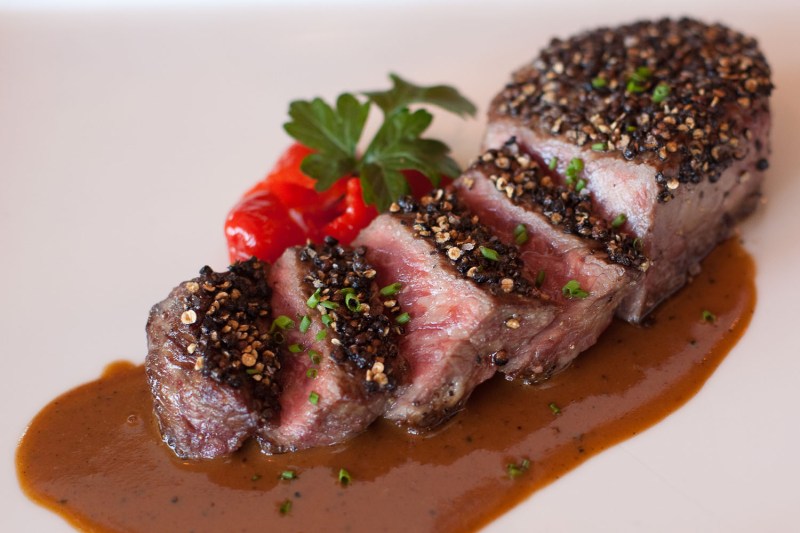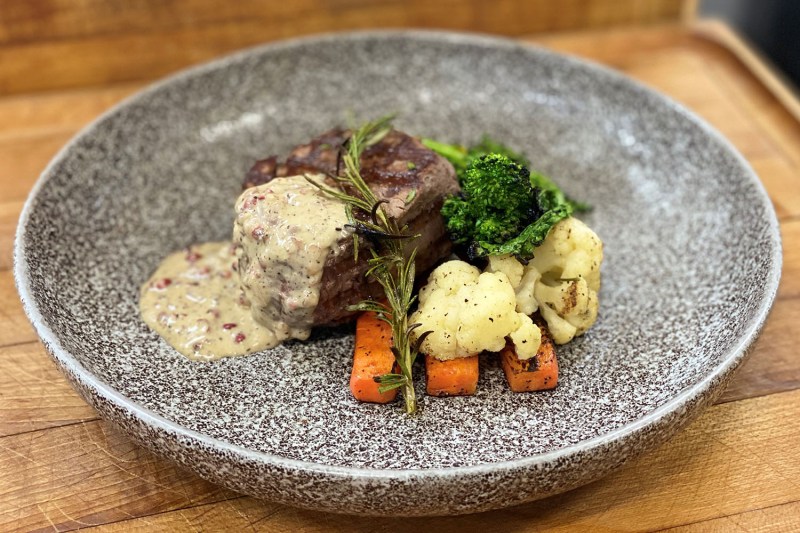
As far as comfort foods are concerned, it’s tough to beat a juicy, tender, perfectly seared cut of steak. With a searing-hot cast-iron skillet, access to a well-appointed butcher shop or counter, and a healthy dose of patience, you can easily create a restaurant-quality steak in your own kitchen … and if you’re feeling ambitious, you can also whip up a bold sauce to highlight the steak’s savory nature. For those who prefer a bit of spice and plenty of Gallic charm with their red meat, steak au poivre provides an elegant and flavorful dinner option. You can also check out our live dinner show for more great recipes.
Related Recipes:
A staple of Parisian bistro menus, “steak au poivre” literally translates to “pepper steak,” an apt name, considering that these steaks arrive lacquered in crushed peppercorns and served with a sauce of cream, liquor, and pepper-steak drippings. Rich, indulgent, and robust, steak au poivre seems designed for a hearty cold-weather nosh. If you want to give it a try at home, we’ve got some useful tips and recipes for you, all volunteered by professional chefs who make this dish on a regular basis.
Really focus on selecting the best possible peppercorns.
The key to an excellent au poivre sauce is savvy peppercorn sourcing. Don’t bother with supermarket containers of pre-ground black pepper; for this recipe, you’ll want to splurge on high-quality whole peppercorns, and you should feel free to get creative with the peppercorn styles you use. Chef de cuisine Allen Schumann of Lobster Bar Sea Grille in Miami Beach, Florida says that to make a great au poivre sauce you need “peppercorns, beef or veal jus, cream and aromatics like garlic, thyme, and shallots. Make sure, when preparing the steak and sauce, that the peppercorns are the stars of the show. I like using a blend of white, pink, black and green peppercorns to add complexity to the flavor and to add a nice color to the dish.”
Look for a steak cut with plenty of marbling, like a New York Strip
When it comes time to choose the cut of steak you’ll use for your au poivre, you can and should rely on your personal preferences. Some chefs like butter-soft filet mignon, others opt for tenderloin, but when we surveyed our group of professionals, one cut stood out as a clear favorite: the classic New York Strip.
“In my personal opinion, a New York Strip is the best cut to use because of its nice fatty marbling – it gives it a depth of flavor that contrasts nicely with the sharpness of the peppercorns,” explains executive chef Bill Williamson of BLT Prime in Washington, D.C.

Executive chef Gabriel Salazar of Sauvage in Brooklyn, NY agrees, adding that “at Sauvage, we use a wet-aged strip, which is what I’d recommend. We found that dry-aged gives too much character to the meat, so you end up with a battle between the au poivre sauce and the dry-aged funk. We choose a strip steak because it’s a perfect piece of meat to sear and get a little bit of char on, and it also is super tender, with a great fat ratio. We use (and I recommend) a 12-ounce cut, which provides a nice thick steak to cook properly and give a good resting time, too. You want to make sure there’s a little bit of the fat cap on the steak, which provides great flavor.”
Let your steak come to room temperature before cooking.
Whatever you do, don’t pull your steak from the fridge and throw it directly onto a hot pan. Instead, follow executive chef Mark Ford of Anoosh Bistro in Louisville, Kentucky’s advice and “let the steak temper to room temperature before cooking, which means letting the steak sit at room temperature for around an hour beforehand. If you use a cold steak, it will drop the temperature of the pan and prevent [the steak from achieving] that thick crust that is indicative of a great steak au poivre.”
Make sure that you’re cooking over even heat.
If you hope to achieve a proper peppercorn crust and a toothsome center, it’s crucial to maintain an even cooking temperature. Executive chef Jordan Moore of Handcraft Kitchen & Cocktails in Mount Pleasant, SC explains why: “[The] peppercorns in an au poivre naturally lend themselves to burning before a nice color and caramelization [ensues], so the proper application of heat [during the] cooking [process] is necessary for optimal results. Just make sure [that] you’re using a nice, even heat with a slight smoke to the oil, [and] make sure you reduce your heat a touch once you hit the pan or grill with a loud sear.”
Always cook steak au poivre in a well-ventilated kitchen.
A kitchen with an operational range fan (or, at least, windows that open) makes the cooking process safer and more comfortable, particularly when you’re prepping a dish that involves high temperatures and the potential for smoke, like steak au poivre. “When preparing the perfect steak au poivre, it’s important to have good ventilation because of the high concentration of peppercorns. If you don’t, inhaling the smoke has the same effect as being pepper-sprayed,” cautions senior corporate chef Michael Ollier of Certified Angus Beef in Wooster, Ohio.
For a perfect au poivre side dish, look no further than a fresh pile of French fries.
When asked about her ideal service method for steak au poivre, executive chef Laetitia Rouabah of Benoit NY in New York City told us that “at Benoit, we serve our Filet Mignon au Poivre with a side of crispy French fries.” The best part about steak frites au poivre? The golden fries can easily be used to sop up the leftover peppery cream sauce.
Ready to make your own steak au poivre? Here are a couple of excellent recipes to get you started:
Chef Richard’s Steak Au Poivre

(Created by Richard Farnabe, Executive Chef, Francis & Staub, New York City)
When creating his steak au poivre recipe, Chef Richard Farnabe chose to hew closely to tradition, stating that “the secret to a great steak au poivre is great ingredients and keeping it simple.” His meat-centric version highlights the unctuous textures and harmonious umami of the ingredients.
Ingredients:
- 4 tenderloin steaks, 6 to 8 oz each and no more than 1.5 inches thick
- Kosher salt
- Thyme, to taste
- 2 tbsp whole peppercorns
- 1 shallot
- 1 clove garlic
- 1 tbsp butter
- 1 tsp olive oil
- 1/3 cup Cognac, plus 1 tsp
- .5 cup heavy cream
- .25 cup beef juice
Method:
- Remove the steaks from the refrigerator and allow to sit at room temperature for at least 30 minutes and up to 1 hour prior to cooking. Sprinkle all sides with salt.
- Coarsely crush the peppercorns with a mortar and pestle, the bottom of a cast-iron skillet, or use a mallet and pie pan. Spread the peppercorns evenly onto a plate. Press the fillets, on both sides, into the pepper until it coats the surface. Set aside.
- In a medium skillet over medium heat, add the olive oil, then gently place the steaks in the pan. For medium-rare, cook for 4 minutes on each side. Once done, remove the steaks to a plate, and set aside. Pour off the excess fat but do not wipe or scrape the pan clean. Chop the shallot, garlic, and thyme and add to the pan. Let cook for 20 seconds over low heat.
- Remove the pan from the heat, add Cognac to the pan, and carefully ignite the alcohol with a long match. Gently shake pan until the flames die. Return the pan to medium heat and add beef juice. Reduce by half and add the cream. Bring the mixture to a boil until the sauce coats the back of a spoon, approximately 5 to 6 minutes.
- Remove from heat, add butter, and season to taste with salt. Add the steaks back to the pan, spoon the sauce over the steaks, and serve.
Chef Edwin’s Steak Au Poivre

(Created by Edwin Gallardo, Executive Chef, Seven Restaurant Grace Bay, Turks & Caicos)
If you’d like to add a bit of zing to this mega-savory dish, try rubbing the steaks with an excellent mustard before coating with peppercorns. “I use the French whole-grain Pommery mustard to create a coating that has more flavor and texture,” advises Chef Edwin Gallardo.
Ingredients:
- 4 8 oz steaks (Gallardo prefers top-cut beef tenderloin)
- 2 tbsp black peppercorns
- 2 tbsp green peppercorns
- 3 tbsp extra virgin olive oil
- 5.5 tbsp unsalted butter
- 1 mL brandy
- 1 tbsp heavy cream
- 1 sprig rosemary
- 8 tbsp beef stock
- 1 tsp mustard (Gallardo prefers Pommery)
- Salt, to taste
Method:
- Crush the peppercorns together using a mortar and pestle or a coffee grinder. Tip the crushed peppercorns into a sieve set over a bowl and shake well to remove all the powdered pepper.
- Rub the steak with mustard. Press the cracked peppercorns onto both sides of the steak and marinate for about half an hour.
- Heat the oil in a thick-bottomed frying pan over medium heat. Once hot, season the steak with salt and place in the pan until a golden crust is formed. Turn the steaks and cook for about two minutes. If you require your meat cooked further, turn the steaks and continue cooking but resist turning them too often.
- Remove the steaks to a warm baking tray or plate and place in the oven to rest and continue to cook to desired doneness.
- Add two-thirds of the butter to the pan and allow it to melt and turn nut-brown in color. Add the rosemary and brandy, being careful that it does not ignite. Bring to a boil and deglaze the pan, stirring to scrape up any bits from the bottom.
- Stir in the cream and the stock and bring to a boil.
- Remove steaks from the oven and place on warm serving plates.
- Add the remaining butter to the sauce and whisk to combine.
- Pour the sauce over the steaks and serve with side of choice.



